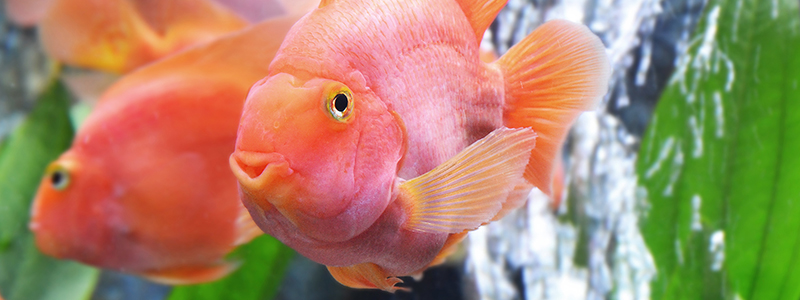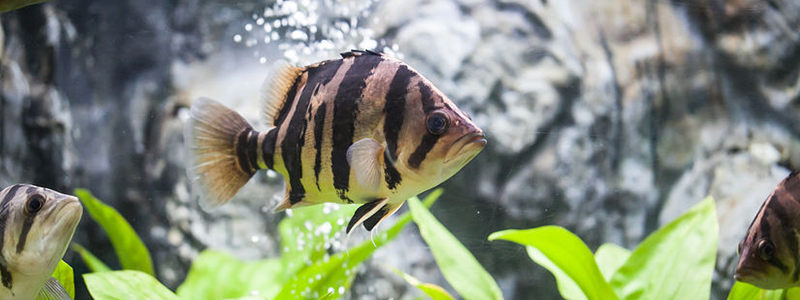Quick Stats: Fahaka Pufferfish
- Family: Tetraodontidae
- Scientific Name: Tetraodon lineatus
- Care level: Intermediate
- Temperament: Large Aggressive – Predatory
- Diet: Carnivore (molluscivore)
- Water conditions: 24-29 degrees Celcius (75-81F), pH 7.0-8.0
- Max Size: 43 – 45 centimeters (17-18 inches)
- Minimum tank size (as an adult): 400 Liters (100 gallons)
Brief Overview: Fahaka Pufferfish Care
The Fahaka Pufferfish, also known as the Nile Puffer, Globe Fish, and Lineatus Puffer, is a large tropical freshwater pufferfish found in the basins of West, Northeast, and East Africa. Like all tetrodons, the Fahaka Puffer can swell up to several times its size when it feels threatened and has outward-protruding spines capable of releasing a neurotoxin called tetrodotoxin.
Identifiable by its yellow stripes and bright orange eyes, The Fahaka can change color based on its mood as well as age. Juveniles tend to be a more mottled color while adults sport the signature yellow bands and red markings. Fahaka Puffers are intelligent and curious and can make for a friendly pet, but also require a large, solitary tank and expensive diet so they are rarely seen in private aquariums.
Fahaka Pufferfish Lifespan
How Long Do Fahaka Pufferfish Live For?
Fahaka Pufferfish have a life expectancy of up to 10 years in an aquarium with proper care and conditions.
How fast/slow should you expect Fahaka Pufferfish to grow?
Fahaka Pufferfish are categorized by a growth rate of 2.5 centimeters (1 inch) per month for the first year, so they should be kept in an appropriately-sized tank early on. Fahaka Puffers should be able to easily swim and turn around in their tank.
What’s a Fahaka Pufferfish’s max size?
Fahaka Pufferfish can grow quite large, upwards of 45 centimeters (18 inches) in length. Like all other pufferfish, Fahaka Puffers are known to puff themselves up even larger using air or water when they feel threatened.
Different types of Freshwater Pufferfish
Fahaka Pufferfish are not the only freshwater puffers. Here are a few others:
Amazonian Puffer (Colomesus asellus): Also known as the Brazilian or Bee Puffer, this species is characterized by distinctive horizontal stripes and only grows to about 9 centimeters (3 inches). One of the more peaceful puffers, this species can usually be housed with other fish (as long as they are fast-moving) and maybe a better choice for those looking to create a community tank.
Avocado Puffer (Auriglobus modestus): This species is also known as the golden or bronze puffer due to their beautiful iridescent coloration. This species is also one of the smaller puffers, reaching approximately 10 centimeters (4 inches) in length. Their smaller size and more streamlined build allow Avocado Puffers to swim quicker than your average puffer, which allows them to more aggressively target any tank mates.
Dwarf Puffer (Carinotetraodon travancoricus): Also known as Pea or Indian Malabar Puffers, Dwarf Puffers are the smallest type of pufferfish, reaching only 2.5 centimeters (1 inch) in length. This species requires feedings more often than other types of pufferfish. Despite their small stature, Dwarf Puffers are still capable of killing much larger fish, so extreme caution must be taken when considering the addition of tank mates.
Pignose Puffer (Tetraodon suvattii): This species of pufferfish is known for its ambush-style of predation. Also known as the Arrowhead or Mekong Puffer, Pignose Puffers either stay relatively still or burrow into the sand until their next meal wanders by. This hunter should not be housed with other fish and can reach 15 centimeters (6 inches) in length.
Fahaka Pufferfish Diet & Feeding
Fahaka Pufferfish have a very expensive diet and messy eating habits. An adult Fahaka Puffer’s dietary needs are more likely to be met in a grocery store than a pet store.
What do Fahaka Pufferfish eat in the wild?
In the wild, Fahaka Pufferfish are categorized as molluscivores. They feed on shellfish and insects, as well as spineless species such as snails, crabs, and crawfish. Insects, mollusks, and crustaceans make a well-rounded diet for a Fahaka Puffer. It is quite common for Fahaka Puffers to chase and prey on different bottom-dwellers of the body of water they inhabit.
What foods are recommended for Fahaka Pufferfish?
Recommended foods for a Fahaka Pufferfish kept in an aquarium include krill meat, small fish, snails, prawns, crab legs, fish fillets, and shrimp. Though some recommend live feeder fish, avoid this method as these fish can introduce diseases into your tank.
Fahaka Pufferfish Feeding habits
A juvenile Fahaka Puffer should be offered food every other day in the form of small fish, snails, krill, and pieces of meat. As the fish matures, offer food 2 to 3 times per week. Adult Fahakas will feed on large prawns, crab legs, fish fillets; an assortment of fresh fish and crustaceans.
Snails and other crustaceans should be offered periodically to wear down the Fahaka’s continuously-growing teeth or they will be unable to eat until the teeth are manually cut.
Fahaka Pufferfish are rather messy eaters, often leaving pieces and leftovers of their meals floating in their tank, so a strong external filter is required in their tank setup to regulate their bio-load levels.

Fahaka Pufferfish Tank Setup
Fahaka Pufferfish have specific needs when it comes to their tank setup.
A brief overview of natural habitat
In the wild, Fahaka Pufferfish occupy tropical freshwater basins such as the Nile, Chad, Senegal, Gambia, Geba, Volta, and Turkana basins. They inhabit large rivers and open water as well as weed beds and other vegetated areas. Fahaka Puffers can also survive in the brackish waters of river mouths.
Fahaka Pufferfish Tank size
Due to Fahaka’s large adult size, they need a large tank of at least 400 liters (100 gallons), with 473 liters (125 gallons) being optimal.
If you are set on attempting to breed or keeping multiple Fahaka Puffers in one tank, the tank should be large enough that the puffers never come into contact with one another, as they will fight every time they see each other.
Fahaka Pufferfish Water conditions
Fahaka Pufferfish should be kept at an ideal temperature between 24 and 29 degrees Celcius (75 – 81 degrees Fahrenheit). Their ideal pH is relatively neutral, between 7.0 and 8.0 and the optimum hardness is between 10 and 12 dGH. Never put your puffer in soft water.
Due to puffers’ lack of scales and or gill covers, they are more sensitive to ammonium and nitrite levels in their aquariums than some other species. Coupled with the messy eating habits and large amounts of waste produced by the Fahaka Pufferfish, prospective owners would do well to invest in an efficient and powerful external canister filtration system capable of replacing the entire tank volume 6-10 times every hour. Weekly water changes of 30% to 50% are also highly recommended. This sensitivity also means you should never cycle your aquarium water while your Fahaka Puffer is in residence.
The Fahaka Pufferfish is a freshwater species but is capable of surviving in brackish water.
Decorations
Provide your pufferfish with a substrate of sand and gravel as well as moderate lighting. Decorations such as smooth rocks or driftwood can make for a more aesthetically-pleasing tank, but you may want to avoid the addition of plants, as most Fahaka Puffers will simply tear these apart during feeding.
Fahakas do not require hides as they swim freely in open water in the wild. As a result, this species should be able to swim freely and turn around in their aquarium tank.
Fahaka Pufferfish Tank Mates
Fahaka Pufferfish are extremely aggressive towards other fish, using their strong teeth to bite chunks out of tank mates. Fahakas should be housed entirely alone.
If you are set on a tank with multiple species, tanks should be very large and species should be fast swimmers the Fahaka cannot catch.
In order to house multiple Fahaka Puffers together, the tank should be large enough that the conspecifics never cross paths, as they will fight every time they come into contact with one another.
Fahaka Pufferfish General Behavior
Though known for their high levels of aggression towards other fish, Fahaka Pufferfish can become friendly pets, even learning to take food directly from your hand. This species is intelligent and curious despite its destructive nature, and with a 10-year lifespan, can become quite used to your presence.

How to Keep Fahaka Pufferfish Healthy
The Fahaka Pufferfish lack of scales or gill covers makes them more prone to disease.
Common diseases to look out for
Like most aquarium fish, Fahaka Puffers are susceptible to ich and are usually the first fish in a tank to become infected. Symptoms of ich include twitching, rubbing their bodies on various surfaces in the tank, and the appearance of white spots on the body and gills. They usually respond well to medication and heal quickly, but you should never use copper in an aquarium housing a Fahaka Puffer.
Most Fahaka Pufferfish are removed from the wild and, as a result, can often carry internal parasites. Deworming should be undertaken as soon as you bring your puffer home if it has not been done already.
Fahaka Puffers are also susceptible to an infection of the gills called Heterobothrium, which can be successfully treated with a formaldehyde bath.
Tips on keeping the Fahaka Pufferfish in good health
Fahaka Puffers are usually relatively easy to keep healthy as long as you are vigilant in monitoring your water quality. Perform water changes and test water quality regularly to keep ammonium and nitrite levels in check, and do not overfeed, as food waste will cause these levels to spike.
Due to their solitary nature, you rarely need to worry about Fahaka Pufferfish catching illnesses from other fish unless you choose to feed your Fahaka Puffers live fish.
Breeding Fahaka Pufferfish
Fahaka Pufferfish have not been bred commercially in captivity, though there have been reports of successful reproduction in specimens owned by hobbyists. Breeding Fahaka Puffers is incredibly difficult due to their aggressive nature and tremendous space requirements.
Sexual differences between male and female Fahaka Puffers are nonexistent, though the female may become slightly more rounded during times of spawning. Aquarists have been successful in acquiring juveniles from the wild, though the deep water in which this species breeds makes this a difficult task.
Interesting Facts About Fahaka Pufferfish
- Fahaka Puffers are a mottled color as juveniles but eventually develop bright yellow horizontal striping and deep red blotches as they mature.
- Fahaka Puffers can change color based on mood.
- Fahaka Puffers can be trained to take food from your hand.
- Even Fahaka Puffer fry can become aggressive and need to be separated from their brood mates.
- Fahaka Puffers grow very quickly: as much as 2.5 centimeters every month!
- The Fahaka Pufferfish is commonly available but, due to their aggressive nature, are rarely sold in retail stores.
Is a Fahaka Pufferfish right for you?
Fahaka Pufferfish have aggressive and destructive tendencies but can make for a very friendly pet under the right conditions. Do not let their solitary nature dissuade you from considering a Fahaka Puffer for your aquarium.




